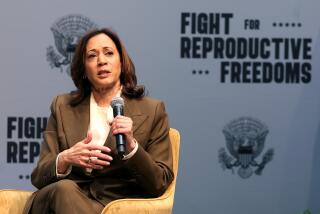Clinton Gives Dole the Key to the ‘Big Tent’
This is a tale of two swing voters.
There is a man in Long Beach who calls himself a Reagan Democrat. He’s a working-class, pro-life Catholic who voted for Ronald Reagan twice and for Ross Perot four years ago. But lately, he’s been worrying about the Republicans in Congress and has been thinking about going back to his old party.
There is a woman in Orange County who calls herself a Clinton Republican. She voted for Bill Clinton in 1992 because she felt that the GOP no longer had room for a pro-choice moderate like herself. Now she’s disappointed with Clinton but needs a sign from Bob Dole that she’s welcome in his Republican Party.
To understand these two voters, and countless others just like them, is to understand the heart of Dole’s abortion dilemma. Both voters feel passionately about the issue, yet their passions run in opposite directions. And in order to win in November, Dole needs them both in his corner.
Having secured his party’s nomination, Dole’s task now is to begin reaching out to the swing votes who will decide this election. But when the topic is abortion, this maneuver becomes more complicated. Does Dole move toward the moderate pro-choice vote or the Catholic pro-life vote?
Both of these key voting blocs are up for grabs this year, and both are there for Dole’s taking if he can find the right message to send them. His challenge is to figure out how to send a message of acceptance to both of them simultaneously.
A window of opportunity has now opened for Dole. Clinton’s recent veto of legislation that would have banned “partial birth” abortions and the howls of outrage the veto drew from the Catholic Church, present Dole with a chance to reach out to those voters. A majority of Americans who support a woman’s right to an abortion also favor some restrictions on that right. Clinton’s veto suggests that he does not.
For Dole to take full advantage of this opportunity also requires him to send a signal of inclusion to the moderate pro-choice voters who abandoned George Bush in 1992. A unilateral gesture, though, risks alienating not only his party’s hard-line conservatives, but also those same pro-life Catholics Clinton has just left on Dole’s doorstep.
The good news is that he has the resources at his disposal to reach both camps: his decisions on a running mate and the content of the party’s platform. These are two of the most telling signals that any nominee sends to the electorate, and together they give Dole the means through which to send both groups of swing voters a message of inclusion.
While Dole’s single most important decision will be the selection of his vice presidential nominee, the significance of the platform’s language is more symbolic. But because the debate over the platform’s call to outlaw abortion has become so heated in recent years, its value as a message vehicle increases to a point where Dole’s direction can serve as a counterbalance to his choice of a running mate.
Once Dole reaches out to either pro-life or pro-choice voters through his vice presidential selection, he can then reach out to the other group through his decision on the platform. So if his eventual selection opposes abortion, as do most of the rumored candidates, then it is incumbent upon Dole to send a message of acceptance to pro-choice voters by removing the party platform’s pro-life plank. Conversely, if he is able to entice Colin Powell to join him on the ticket, or decides on another prominent pro-choicer, then it is imperative that he allow the plank to remain intact.
To completely ignore either bloc in favor of the other forfeits the support of voters that he needs to beat Clinton. But by reaching out in both directions, Dole sends a message that his Republican Party has room for both groups.
Dole’s ultimate objective, therefore, must be to redefine the current partisan division of abortion politics. He must convince voters that their choice is not between pro-life and pro-choice parties, but rather between a party that encourages discussion on both sides of the issue and one that allows no debate at all.
Former GOP Chairman Lee Atwater’s goal was to identify Republicans as the “big tent” party that welcomed both pro-choice and pro-life voters. Bob Dole can make that goal a reality, and maybe get elected president in the process.
More to Read
Get the L.A. Times Politics newsletter
Deeply reported insights into legislation, politics and policy from Sacramento, Washington and beyond. In your inbox three times per week.
You may occasionally receive promotional content from the Los Angeles Times.










